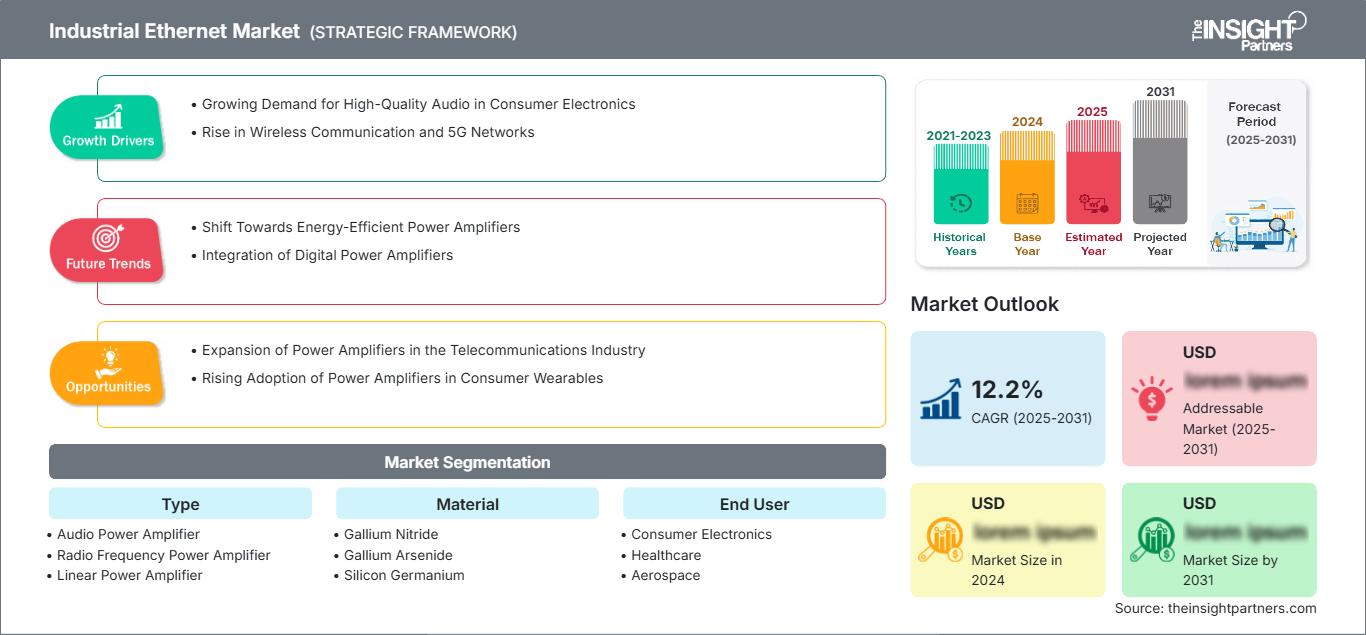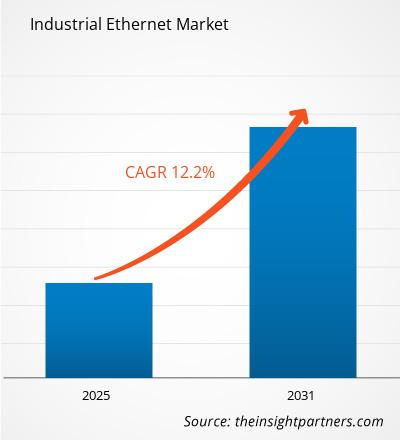页面已更新 :
Jan 2025
预计功率放大器市场在 2025 年至 2031 年期间的复合年增长率为 12.2%,市场规模将从 2024 年的 XX 百万美元扩大到 2031 年的 XX 百万美元。
该报告按类型(音频功率放大器、射频 (RF) 功率放大器和线性功率放大器)、材料(氮化镓 (GaN)、砷化镓 (GaAs) 和硅锗 (SiGe))和最终用户(消费电子、医疗保健、航空航天和国防、电信等)细分。全球分析进一步细分为区域和主要国家。该报告以美元提供上述分析和细分的价值。
报告目的
Insight Partners 撰写的《功率放大器市场》报告旨在描述当前形势和未来增长、主要驱动因素、挑战和机遇。这将为各种商业利益相关者提供见解,例如:
- 技术提供商/制造商:了解不断变化的市场动态并了解潜在的增长机会,使他们能够做出明智的战略决策。
- 投资者:对市场增长率、市场财务预测和整个价值链中存在的机会进行全面的趋势分析。
- 监管机构:规范市场政策和警察活动,旨在最大限度地减少滥用,维护投资者的信任和信心,维护市场的完整性和稳定性。
功率放大器市场细分类型
- 音频功率放大器
- 射频功率放大器
- 线性功率放大器
材料
- 氮化镓
- 砷化镓
- 硅锗
最终用户
- 消费电子
- 医疗保健
- 航空航天
- 国防
- 电信
- 其他
地理分布
- 北美
- 欧洲
- 亚太地区
- 南美和中美
- 中东和非洲
自定义此报告以满足您的要求
您将免费获得任何报告的定制,包括本报告的部分内容,或国家级分析、Excel 数据包,以及为初创企业和大学提供超值优惠和折扣
工业以太网市场: 战略洞察

- 获取本报告的主要市场趋势。这个免费样本将包括数据分析,从市场趋势到估计和预测。
功率放大器市场增长动力
- 消费电子产品对高品质音频的需求不断增长:高清音频和视频设备在消费电子产品中的日益普及是功率放大器市场的主要驱动力之一。随着家庭影院系统、游戏机和高端音响设备的兴起,对功率放大器的需求也日益增长,以提升音质,为消费者提供清晰、无失真的音频体验。这种对沉浸式音效日益增长的需求极大地促进了市场的增长。
- 无线通信和 5G 网络的兴起:5G 网络的推出和无线通信技术的日益普及正在推动对功率放大器的需求。这些放大器对于长距离传输信号至关重要,尤其是在基站、智能手机和物联网设备等通信系统中。随着对更快、更可靠的无线连接的需求日益增长,功率放大器对于确保这些网络的高效运行至关重要。
功率放大器市场未来趋势
- 向节能功率放大器转变:功率放大器市场的主要趋势之一是对节能放大器的需求不断增长。随着人们对能源消耗和环境可持续性的认识不断提高,制造商正致力于设计能够提供高输出同时消耗更少功率的功率放大器。节能功率放大器对于移动设备、电信和消费电子产品中的应用至关重要,因为功率效率是这些应用的关键因素。
- 数字功率放大器的集成:市场上另一个值得注意的趋势是数字功率放大器的集成度不断提高。与传统的模拟放大器相比,这些放大器效率更高、信号处理性能更佳,体积更小。随着数字信号处理 (DSP) 技术的进步,数字功率放大器正被用于各种应用,例如无线通信、广播和音频系统,从而实现更紧凑、更具成本效益和功能更强大的解决方案。
功率放大器市场机遇
- 电信行业功率放大器的扩张:对高速数据传输的日益增长的需求,尤其是随着 5G 网络的扩展,为功率放大器市场带来了巨大的机遇。这些放大器对于电信基础设施至关重要,包括基站、中继器和其他支持无线通信的设备。随着电信运营商投资 5G 部署和数据中心扩展,功率放大器对于确保无缝信号放大和网络性能至关重要。
- 消费可穿戴设备中功率放大器的采用率不断上升:包括智能手表、健身追踪器和增强现实 (AR) 眼镜在内的可穿戴电子市场的快速增长,为功率放大器市场带来了机遇。随着可穿戴设备日益先进,功率放大器越来越多地用于提升无线通信、音频和电池供电功能的性能。对便携式高效音频和通信系统日益增长的需求为功率放大器制造商创造了巨大的机遇。
工业以太网市场区域洞察
The Insight Partners 的分析师已详尽阐述了预测期内影响工业以太网市场的区域趋势和因素。本节还讨论了北美、欧洲、亚太地区、中东和非洲以及南美和中美洲的工业以太网市场细分和地域分布。
工业以太网市场报告范围
| 报告属性 | 细节 |
|---|---|
| 市场规模 2024 | US$ XX million |
| 市场规模 2031 | US$ XX Million |
| 全球复合年增长率 (2025 - 2031) | 12.2% |
| 历史数据 | 2021-2023 |
| 预测期 | 2025-2031 |
| 涵盖的领域 |
By 类型
|
| 覆盖地区和国家 | 北美
|
| 市场领导者和主要公司简介 |
|
工业以太网市场参与者密度:了解其对业务动态的影响
工业以太网市场正在快速增长,这得益于终端用户需求的不断增长,而这些需求的驱动因素包括消费者偏好的不断变化、技术进步以及对产品优势的认知度不断提高。随着需求的增长,企业正在扩展其产品线,不断创新以满足消费者需求,并抓住新兴趋势,从而进一步推动市场增长。

- 获取 工业以太网市场 主要参与者概述
主要卖点
- 全面覆盖:本报告全面涵盖了功率放大器市场的产品、服务、类型和最终用户的分析,提供了整体格局。
- 专家分析:本报告基于对行业专家和分析师的深入了解而编写。
- 最新信息:本报告涵盖了最新信息和数据趋势,确保了业务相关性。
- 定制选项:本报告可以根据特定客户要求进行定制,并恰如其分地适应业务策略。
因此,功率放大器市场研究报告可以帮助引领解读和理解行业情景和增长前景的步伐。尽管可能存在一些合理的担忧,但本报告的总体优势往往大于劣势。
- 历史分析(2 年)、基准年、预测(7 年)及复合年增长率
- PEST和SWOT分析
- 市场规模、价值/数量 - 全球、区域、国家
- 行业和竞争格局
- Excel 数据集
近期报告
客户评价
购买理由
- 明智的决策
- 了解市场动态
- 竞争分析
- 客户洞察
- 市场预测
- 风险规避
- 战略规划
- 投资论证
- 识别新兴市场
- 优化营销策略
- 提升运营效率
- 顺应监管趋势
我们的客户































87-673-9708

ISO 9001:2015



 获取免费样品 - 工业以太网市场
获取免费样品 - 工业以太网市场